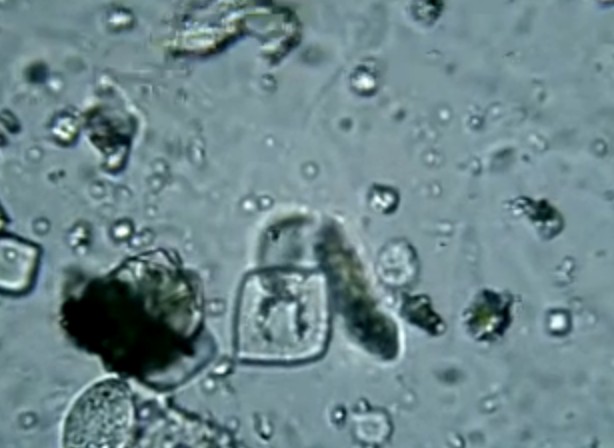Uric acid is a by-product of the body’s metabolic break down of purine, a substance that is naturally present in the body and in certain foods. It is removed from the body along with urine.
Uric acid produced in the body passes via the bloodstream to the kidneys where it is filtered and eventually eliminated from the body. Sometimes, the kidneys may not be able to fully remove all the uric acid from the body, or the body may commence the production of increased amounts of the said acid. This can then result in elevated levels of uric acid in the blood; an abnormal condition medically termed as hyperuricemia.Doctors maintain that the normal range of uric acid in the body falls between 3.6 mg/dL and 8.3 mg/dL.
Presence of high levels of uric acid in the body causes it to accumulate in the body as uric acid crystals. The crystals then pass out along with the urine. As explained above, the presence of uric acid crystals in urine is thus a sign of some underlying health problem.
Symptoms
The passage of uric acid crystals in urine and the severity of accompanying signs and symptoms is usually dependent on the overall content of uric acid in the body.
High levels of uric acid in the body typically does not cause any serious health problems. Some patients may however develop varied medical complications like kidney stones, gout, kidney failure, etc. Most of the symptoms that accompany the elimination of uric acid crystals in urine arise due to the presence of such complications.
Kidney stones: They are hardened lumps that form due to deposition of waste matter in the blood. Increased levels of uric acid in the blood can result in the formation of uric acid crystals within the kidneys. The condition typically does not result in any visible symptoms, until such time when 1 or more of the kidney stones pass via the ureters into the bladder. Patients with this complication of uric acid crystals in urine may elicit the below listed symptoms:
- Intense pain which commences suddenly and ends as abruptly. The pain is generally experienced on the side or back of the abdomen.
- Pain may persist for a few minutes or some hours; it may be interspersed with periods of no pain.
- The testicles and groin area may also elicit pain.
- Patients may feel pain when passing urine. Urination may or may not occur along with burning sensations.
- Vomiting and nausea. If affected individuals develop an infection then fever also occurs.
- The urine may be brown, red, or pink in color. It may be cloudy and/or have a putrid odor.
- Increased desire to frequently pass urine, along with elevated urine content.
Gout:Increased levels of uric acid in the blood can result in the formation of needle-like hardened uric acid crystals. They may occur inside different joints and/or in the adjacent tissues and eventually cause symptoms such as:
- Affected joints may experience sharp and intense pain. Most patients experience such bouts of pain in the night while asleep. The pain my become more severe and aggravate at the slightest of touches, such as that by a bed sheet.
- There is swelling, inflammation, redness, and tenderness, typically of the big toe. Other affected joints include the ankle, foot, hands, knees, and wrists.
- In addition to uric acid crystals in urine, the episodes of lingering gout pain may persist for some days or even weeks.
Chronic kidney failure: It is characterized by reduced or nil capacity of the kidneys to filter waste matter from the blood. In addition to uric acid crystals in urine, patients may experience the following symptoms:
- Dry and itchy skin
- Fluid retention leading to swollen limbs
- Fatigue and headaches
- Nausea and malaise
- Appetite loss
- Inexplicable loss of weight
- Fluid deposition in the lungs leading to breathing problems
- Hypertension
- Bloody urine
- Sleeping difficulties
- Cognitive deficits
- Lowered urine output

Causes of uric acid crystals in urine
Uric acid is produced as a byproduct of the metabolic action on purines. Purines naturally occur in the body as well as in food items such as dried beans, meat, sea fish, anchovies, and oatmeal, etc.
Some of the common causes of uric acid crystals in urine are listed below:
- Increased intake of foods that are abundant in purines can cause the uric acid levels in the blood to rise, eventually resulting in uric acid crystals in urine.
- If the kidneys are unable to breakdown and filter uric acid at a rate that is equal to their rate of production, then the uric acid turns into calcium oxalate crystals, commonly called seed crystals, and passes out as crystals in urine.
- High levels of uric acid in the blood as well as uric acid crystals in urine are associated with a variety of diseases and disorders, including obesity, gout, hypothyroidism, cardiovascular diseases, metabolic syndrome, certain types of cancer, diabetes, Lesch-Nyhan syndrome, kidney dysfunction, psoriasis, urolithiasis, and lead poisoning.
- Uric acid crystals in urine can also arise due to other factors such as hereditary reasons, alcohol abuse, intake of niacin or vitamin C supplements, starvation, use of diuretics, and chemotherapy treatment.
Treatment and diet
Uric acid crystals in urine can be treated with medications and diet changes. Associated complications of uric acid crystals in urine are treated as per standard procedures.
- Uric acid levels in the blood can be lowered with medications such as allopurinol, febuxostat, probenecid, and sulfinpyrazone.
- Pain killers can help alleviate discomfort and pain.
The below listed food items should be included in the diet:
- Foods rich in complex proteins such as celery, parsley, berries, cabbage, and tofu.
- Foods with low purine and low protein content such as pasta, vinegar, peanut butter, corn, eggs, whole wheat breads, rice, cherries, tart, gelatin, and cheese.
- Bromelain and vitamin C abundant foods like low-fat dairy products, flax seeds, salmon, red cabbage, fibrous foods, soy products, different nuts, olive oil, red bell peppers, pineapples, and lemon juice.
- Foods with high potassium content such as yam, cereals, dried peaches, yogurt, and bananas.
The below listed food items should be avoided:
- High-content purine food items such as processed meat, tuna, anchovies, shrimp, pork, yeast, beer, mincemeat, sardines, mussels, scallops, lamb, sweetbread, and organ meats such as kidney, liver, etc.
- Medium-level purine foods like lobsters, oatmeal, goose, asparagus, legumes, lentils, cauliflower, mushroom, soda, bacon, chicken, turkey, peas, dried beans, and spinach.


